
Joseph Hunkin (1610-1661) [2] of Gatherleigh [3] in the parish of Lifton in Devon, was Governor of Scilly between 1651 and 1660, during Parliamentary control in the Civil War. [4]

Joseph Hunkin (1610-1661) [2] of Gatherleigh [3] in the parish of Lifton in Devon, was Governor of Scilly between 1651 and 1660, during Parliamentary control in the Civil War. [4]
He was the son and heir of John Hunkin (d.1629) of Gatherleigh, High Steward of the Borough of Liskeard in Cornwall (son of John Hunkin (d.1608) first Mayor of Liskeard elected on the re-incorporation of that Borough on 6 July 1587) by his first wife Grace Clobery, a daughter of Andrew Clobery (d.1596/7) [5] of Lifton [6] in Devon, [7] 2nd son of John Clobery of Bradstone, [8] Devon, near the Cornish border.
He was Governor during the construction of Cromwell's Castle, an artillery fort overlooking New Grimsby harbour on the island of Tresco in the Isles of Scilly. According to the Acts and Ordinances of the Interregnum 1642–1660[ full citation needed ] he was a commissioner for Devonshire for December 1649, December 1652 and June 1657.
In 1630 at Boyton, he married Frances Loveys (d.1657), [9] a daughter of Robert Loveys of Beardon in Cornwall. Her mural monument, a simple slate tablet, survives on the external wall of Old Town Church, St Mary's, Isles of Scilly, inscribed as follows: [10]
He was buried on 15 August 1661 at Lifton in Devon. [11] A later prominent member of the Hunkin family was Joseph Hunkin (1887-1950), born in Truro, Cornwall, the 8th Bishop of Truro from 1935 to 1950. His monument in Truro Cathedral displays the arms of Hunkin of Gatherleigh, namely: Argent, a mascle sable over all a fess of the last. [12]
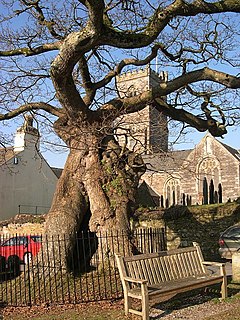
Meavy is a small village, civil parish and former manor in the English county of Devon. Meavy forms part of the district of West Devon. It lies a mile or so east of Yelverton. The River Meavy runs near the village. For administrative purposes the parish is grouped with the parishes of Sheepstor and Walkhampton to form Burrator Parish Council, and for electoral purposes it is grouped with the same two parishes to form Burrator Ward.
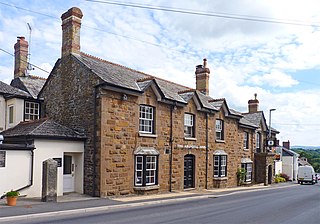
Lifton is a village and civil parish in Devon, South West England near the confluence of the rivers Wolf and Lyd, 1¼ miles south of the A30 trunk road and very near the border between Devon and Cornwall. The village is part of the electoral ward of Thrushel. The population of the surrounding Thrushel ward at the 2011 census was 1680.

Sir Jonathan Trelawny, 2nd Baronet, of Trelawny in the parish of Pelynt in Cornwall, England, was a Member of Parliament.
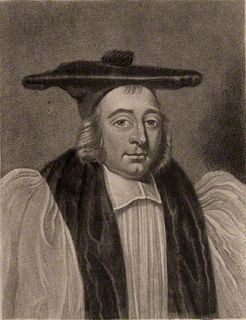
Nicholas Monck was a Bishop of Hereford and Provost of Eton College, both royal appointments made by King Charles II following the 1660 Restoration of the Monarchy which was largely effected by his elder brother George Monck, 1st Duke of Albemarle (1608–1670), KG. Nicholas Monck was "a great assistant in the Restoration to his brother".

Lawhitton is a village in the civil parish of Lawhitton Rural, in east Cornwall, England, United Kingdom. The village is situated two miles (3 km) southwest of Launceston and half-a-mile west of Cornwall's border with Devon at the River Tamar.

Joseph Wellington Hunkin was the eighth Bishop of Truro from 1935 to 1950.

Sir Thomas Wise, KB, of Sydenham in the parish of Marystow and of Mount Wise in the parish of Stoke Damerel in Devon, was Sheriff of Devon in 1612 and in 1621 served as a member of parliament for Bere Alston in Devon.
John Harris (1596–1648) of Lanrest, Liskeard in Cornwall and of Radford in the parish of Plymstock in Devon, was an English gentleman who was elected four times as a Member of Parliament for Liskeard in Cornwall, between 1628 and 1644. He supported the Royalist side in the Civil War.

John Harris of Hayne in the parish of Stowford in Devon and of St. Michael's Mount in Cornwall, was a Member of Parliament.

Christopher Harris of Lanrest in the parish of Liskeard in Cornwall, was a Member of Parliament for West Looe in Cornwall (1621). He should not be confused with his great-uncle Christopher Harris (c.1553-1625) of Radford in the parish of Plymstock in Devon, MP for Plymouth in 1584, whose heir apparent he was.
Sir Thomas Carew, 1st Baronet of Haccombe, Devon, was an English politician who sat in the House of Commons from 1661 to 1674.

.

The landed gentry and nobility of Devonshire, like the rest of the English and European gentry, bore heraldic arms from the start of the age of heraldry circa 1200–1215. The fashion for the display of heraldry ceased about the end of the Victorian era (1901) by which time most of the ancient arms-bearing families of Devonshire had died out, moved away or parted with their landed estates.
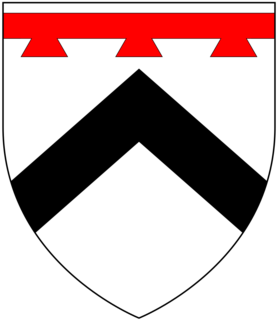
Sir Peter Prideaux, 3rd Baronet (1626–1705), of Netherton in the parish of Farway, near Honiton, Devon, was an English politician.
Lieutenant-Colonel John Lambrick Vivian (1830–1896), Inspector of Militia and Her Majesty's Superintendent of Police and Police Magistrate for St Kitts, West Indies, was an English genealogist and historian. He edited editions of the Heraldic Visitations of Devon and of Cornwall, standard reference works for historians of these two counties. Both contain an extensive pedigree of the Vivian family of Devon and Cornwall, produced largely by his own researches.

John Wrey of North Russell, Sourton, and Bridestowe in Devon and Trebeigh, St Ive, Cornwall, was Sheriff of Cornwall in 1587.

John Calwoodleigh of the City of Exeter in Devon, was twice Mayor of Exeter, in 1502 and 1508. He was a Churchwarden of St Petrock's Church, Exeter.

Wortham is an historic manor within the parish of Lifton in Devon, England. The early sixteenth century manor house survives, today the property of the Landmark Trust. It was long the seat of the Dynham family, a junior branch descended from the Anglo-Norman magnate Baron Dynham. A mural monument survives in Lifton Church to John Dynham (d.1641) of Wortham, consisting of an escutcheon showing the arms of Dynham of Wortham impaling Harris of Hayne ) with the crest of Dynham above: An arm couped or hand azure holding a lock of hair sable, with an inscribed tablet beneath. John Dynham (d.1641) was the last in the male line and married Margaret Harris (d.1650), a daughter of Arthur Harris (1561-1628) of Hayne in the parish of Stowford and lord of the manor of Lifton, both in Devon, and of Kenegie in the parish of Gulval in Cornwall, Sheriff of Cornwall in 1603 and Captain of St Michael's Mount, Cornwall. Arthur Harris's grandfather John Harris (d.1551) of Hayne, a Serjeant-at-Law and Recorder of Exeter, had purchased the manor of Lifton from the Nevile family, Earls of Northumberland. John Dynham (d.1641) died without children whereupon his heir was his niece Mary Hex, a daughter of his sister Margaret Dynham by her husband John Hex of Alternon in Cornwall, who married John Harris of Lifton, consequently Wortham passed to the Harris family.
A customer is an archaic term for a government appointed official who is empowered to collect taxation in the form of customs duty in certain defined physical locations or jurisdictions.
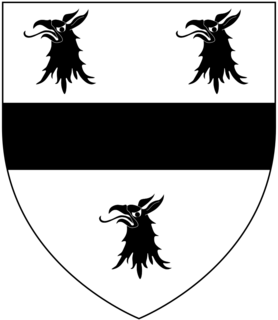
Kenedon is an historic manor situated in the parish of Sherford in Devon.